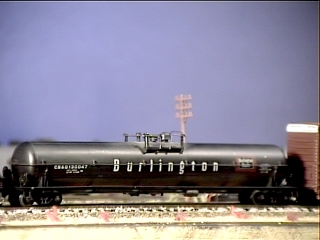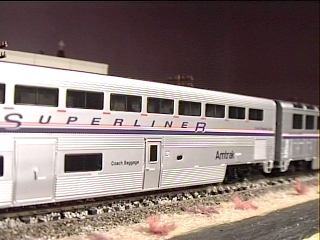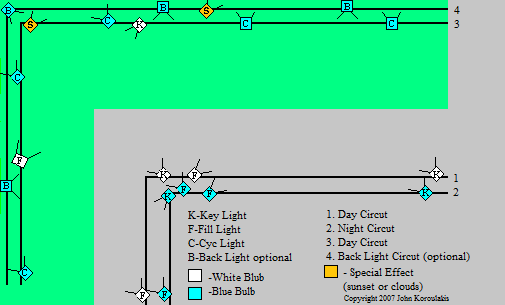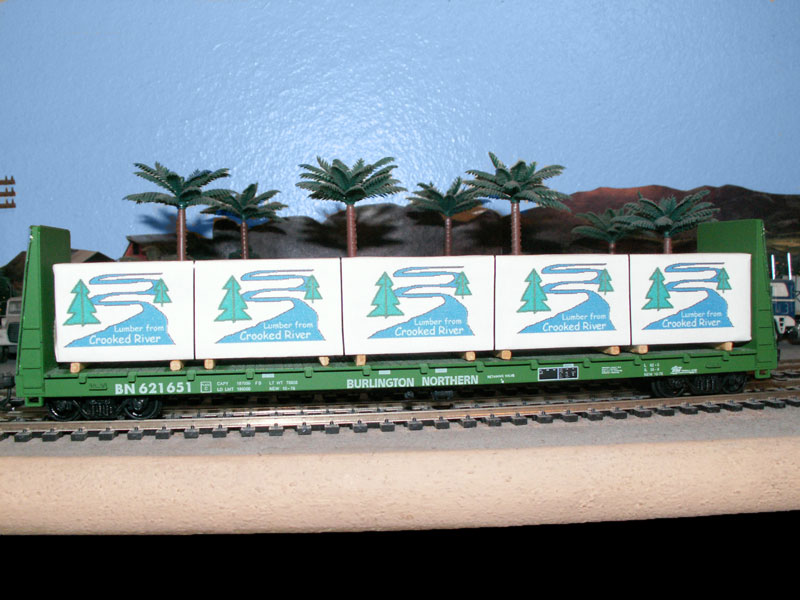Lighting Design
| Bright lights which are properly aimed at the scenes make them more vivid and come to life. They make the colors pop! I design my lighting using theatre and television techniques. The aisles are dark and the lights shine only on the action. Everything below the layout in covered in black, making it invisible. All you see is the layout floating above the darkness. Kind of like a Disneyland ride, you are surrounded by the attraction, fully immersed. |
 |
A freight train sits on the main line during the day. White lights shine on the scene while blue light shines on the white color cyclorama backdrop (cyc). Clouds can be added by using a special white light with a cloud shaped gobo. A beautiful sunset can be added by mixing in orange red and yellow lights to the blue cyc lights. |
 |
The Southwest Chief flies by at night. The cyc lights are black while the white key lights shine on the train to simulate this snapshot using a large flash. No lights at all shine on the backdrop. Lights are carefully aimed so they only shine on the scenery, not the sky. |
 |
The West Side comes alive at night. Controlled lighting means you can create some really great atmosphere. |
Compare Track Lighting To Other Options. Type of Light Pros Cons Track Lighting * Easily aim light.
* Easily reposition light.
* Can use dimmers
* Easy wiring.
* Choice of color.
* Cheap Bulbs.
* Photo Ready.* Heat - incandescent bulbs burn hot. (This could be a plus because it can save on heating in winter.)
* Power Usage - Lots of lights left on can add up. (If you are good at conserving, it's no problem.)Porcelain Key Light
(like the one in the attic or garage.)* Can use dimmers
* Choice of color
* Cheap Bulbs
* Photo Ready* Can't move or aim light
* Heat
* Power Usage
* Complex WiringFluorescent Lights * Low Power Consumption.
* Low Heat.* Yucky blue green color makes you think you're still at work.
* Bad for photography.
* Can't aim.
* Complex Wiring
* Can't Dim
* Buzzes in your ears until you go mad.
* Buzzes the audio on your video camera, TV, stereo and computer.
* Expensive bulbs and ballast.Theatrical Lights * Gives you perfect lighting. * Very expensive
* Uses far to much power
* Heat will melt modelsSunlight * It's free all day long. * Casts harsh shadows.
* Needs windows or skylights
* Can't aim
* Doesn't work at nightCandle Light * Uses no electricity * Causes a scale forest fire which is fanned by the air condition, catching every structure on fire, causing a scale size National Disaster Area. It then continues to burn the benchwork and the walls. The now very real fire burns down your house and possibly kills everyone in it. It's a good thing you always keep fresh batteries in your smoke detector.
I love my track lighting. It is very versatile. If you are trying to create a miniature world you should try to control the miniature sun and moon. Track lighting gives you the most control. You can easily position and aim the lights as needed. You can use several different styles and colors of bulbs. Because the bulbs are incandescent you can use dimmers on them.
The track lights are aimed so that they shine light only on the layout. The rest of the room is dark. Usually this is done with lights centered over the aisles near the ends of the scene aimed left or right at approximately 45 degree angles toward the center of the scene so that there is light shining over your shoulders onto the scene in front of you from both sides. You have to experiment a little to find the best placement. That's where the track lighting comes in. You just move the fixture down the track until you find the best spot for it.
You can get track lighting anywhere they sell lighting. I've found that Home Depot is better stocked and less expensive than Lowe's. I prefer fixtures which can easily be aimed and in which they're hinged on the socket instead of a frame which holds the bulb. Mostly I use the lowest wattage indoor flood light bulbs. I use blue lights on a separate set of tracks for a night effect.
I have two tracks down the center of the aisles and two tracks a few inches from the back wall. One track in the center has white bulbs while the other track has blue with an occasional yellow. The track closest to the wall holds the back lights which are blue. The other back track hold the cyc lights which illuminate the backdrop. They could be blue, red, yellow, orange or white depending on the desired effect.
Key, Back and FillTechnically speaking, 3 point lighting is the best design for light placement. In 3 point lighting there are 3 different light sources pointed at the subject. The main light, known as the Key Light (K), is best located 45 degrees to the left or right side and 45 degrees to the front. This light can casts some harsh shadows so another light, the Fill Light (F), is located on the opposite side to fill in the shadows. A third light, the Back Light (B), sometimes called the hair or rim light, is aimed at the subject from behind. This, especially in photography, helps to separate the subject from the background and create distance. When using backlights be sure to aim them or flag them off so that they don't shine into the viewers eyes.
A fourth set of lights, known as the Cyclorama Lights or Cyc lights, shine on the backdrop. Besides lighting it up they can also be used to create effects like clouds and sunsets.
|
Lighting grid for corners on a large layout.
 |
In this arrangement there are two sets of key and fill lights, white for day and blue for night. Using the dimmers you can lower the light on the background and create an evening or night effect. If you want to go the next step, add tracks of red, orange and yellow lights for spectacular sunsets. Add extra fixtures to the cyc light track with white bulbs and using tin make a cloud shaped gobo to add clouds to the sky. |
I can not stress the importance of roughing in all electrical, air, and plumbing prior to everything else. If you are building a room everything should go in the walls and ceiling before they are dry walled. It saves countless headaches. One home run of 12/3 Romex is good for 2 20 watt circuits. It takes the same amount of work to put in one circuit as it does two so it's best to get two. (No brainer)
You may need at least two circuits depending on how many watts the lights use.
The formula is volts times amps equals watts. 110v times 20 amps equals 2200 watts. 2200 watts is the level at which the breaker will trip. So you can safely use ten to twelve 150 watt bulbs on a circuit. However, the more lights that you have on a circuit, the more likely it is that you may experience voltage drop. So it is better to split up the load onto two circuits.
The home runs should go from the panel or sub panel to the switch box. This should be in a easy to get to location at 48" high. I like to use at least 4 tracks, each with it's own dimmer. This gives you more control. So each circuit supplies power to two dimmers. For large club size layouts you may need additional circuits.
I locate two tracks near the back wall and two tracks over the aisles. One track is for white bulbs and the other is for color.
Don't forget the "House Lights"
The track lights are not the only lights in the room. It's a good idea to have a couple of work lights which you can turn on without firing up the whole show. These are separate lights in the aisles which are used as work lights but are turned off when operating the railroad. Florescent or porcelain key fixtures in the isles will do. Use them when cleaning and working on the layout or under it.
| Berdoo |
|
|
|
|
Sand Mountain | High Desert | Barstow |
Check out our items for sale!





Copyright 2003 Updated 5/26/2020
Sunset West Productions